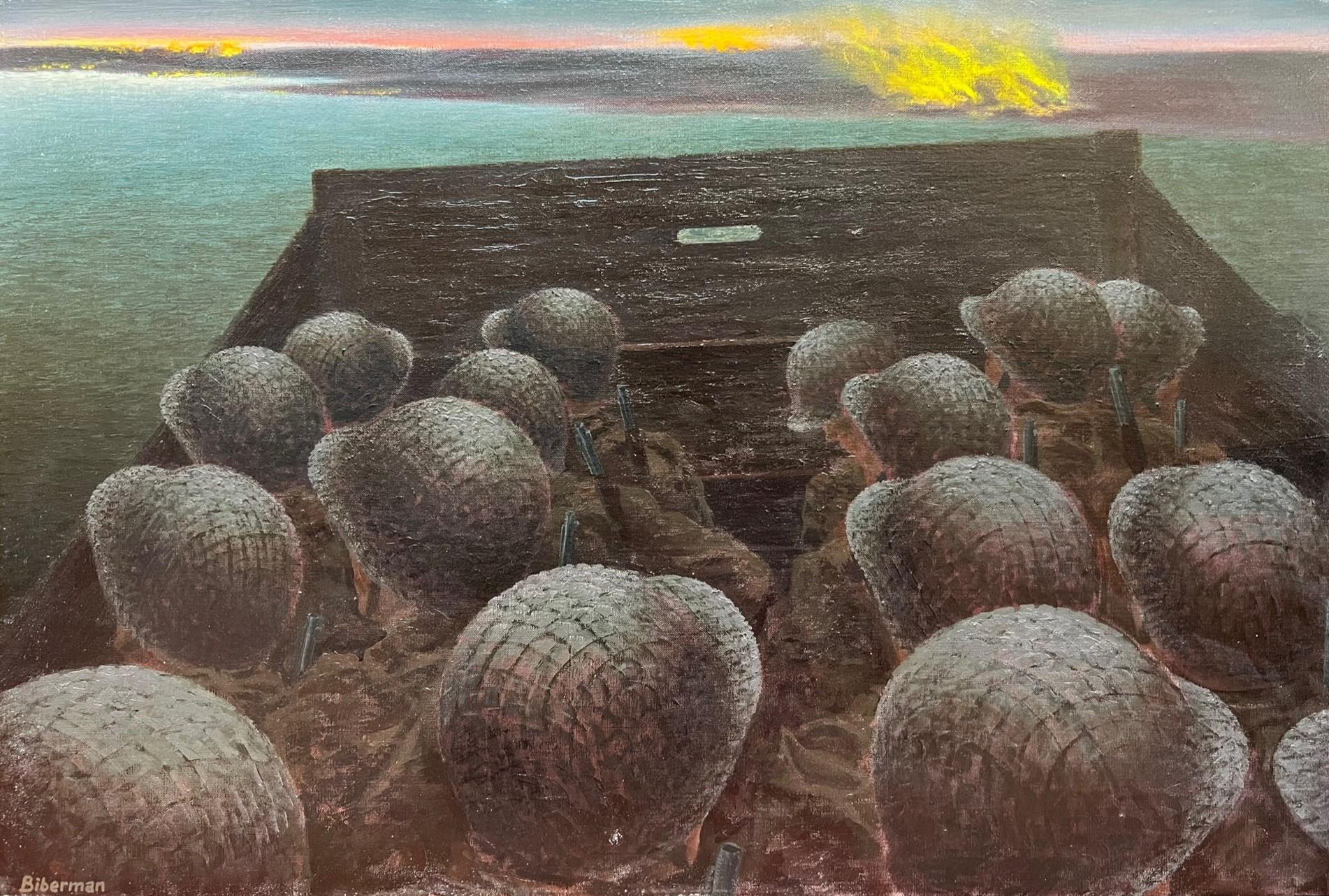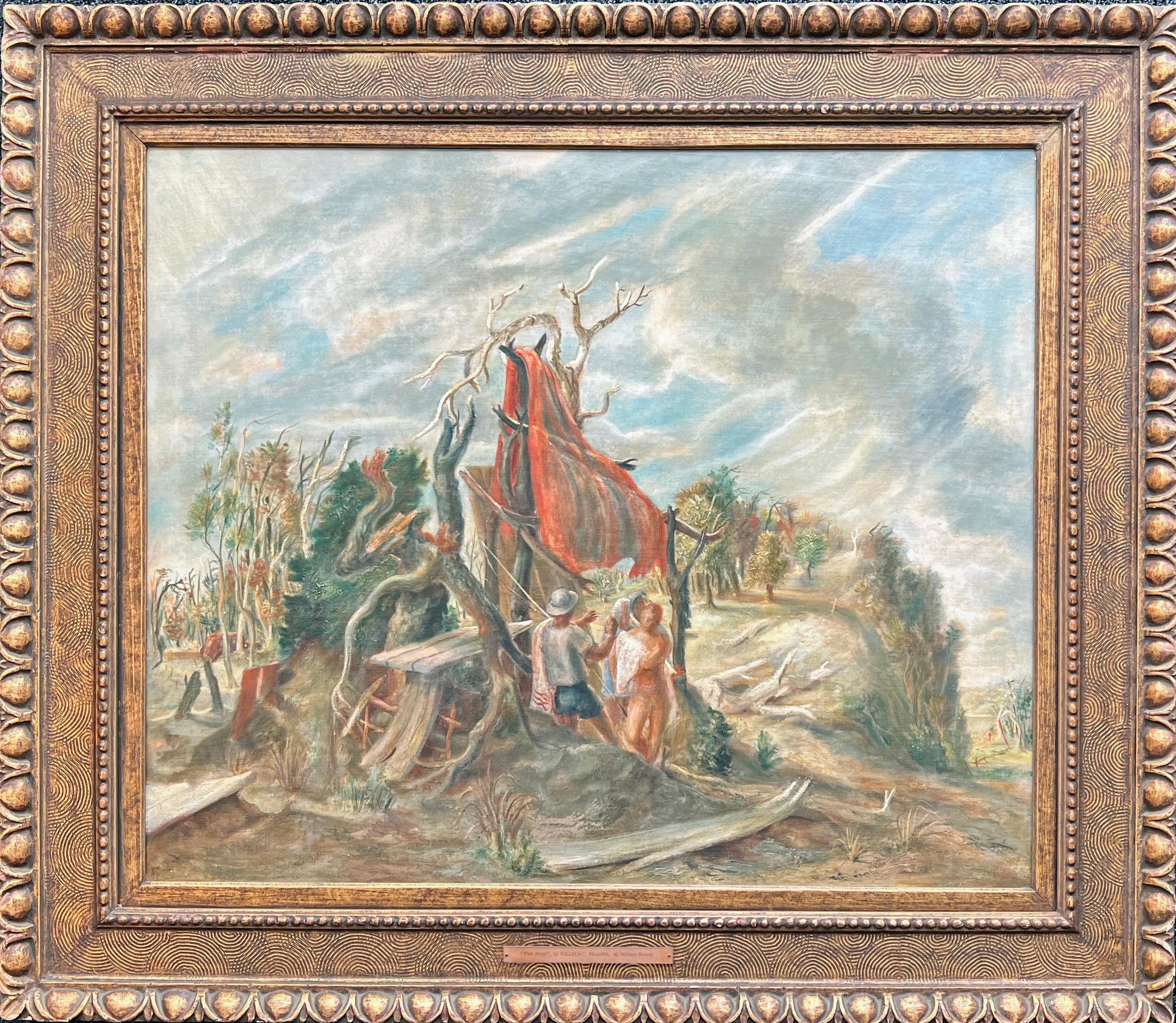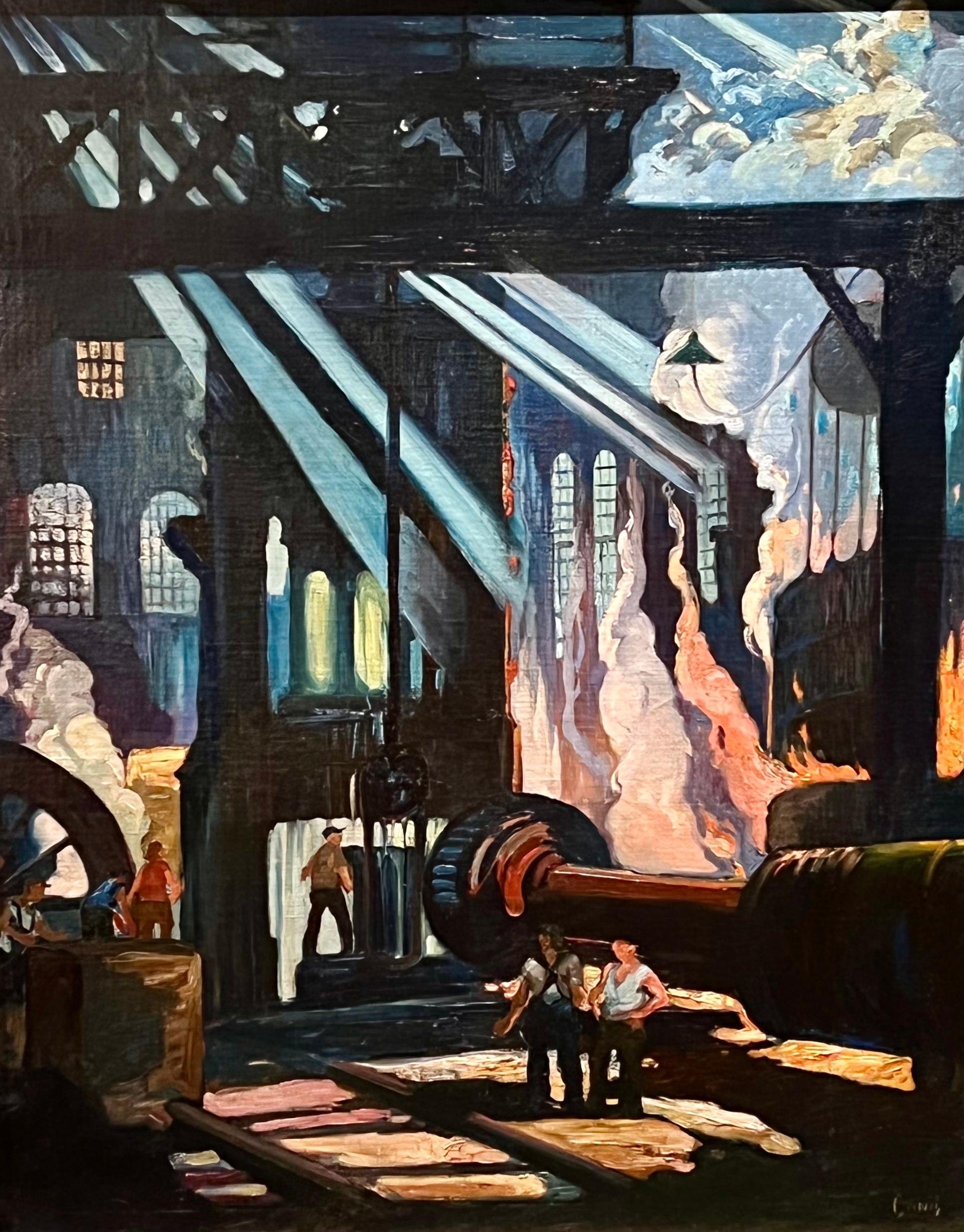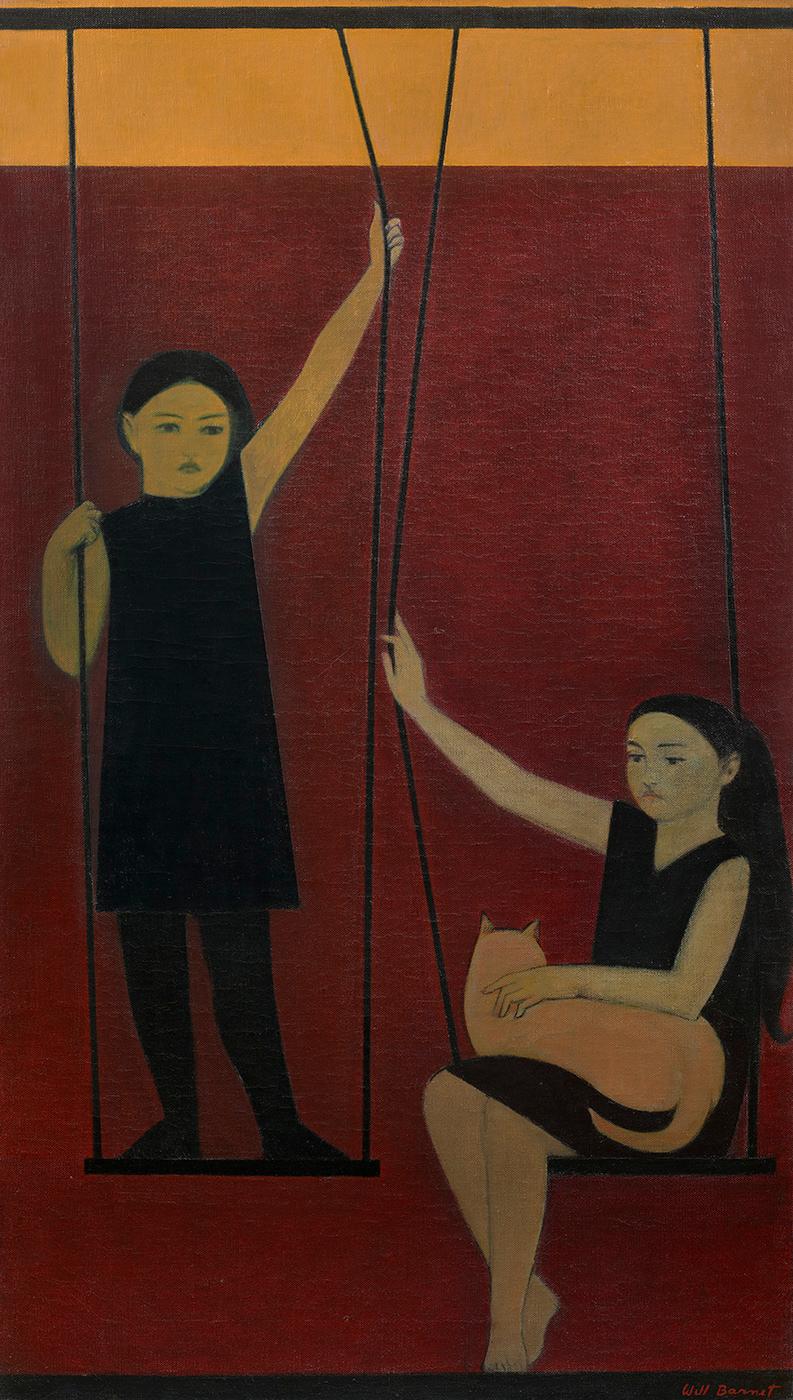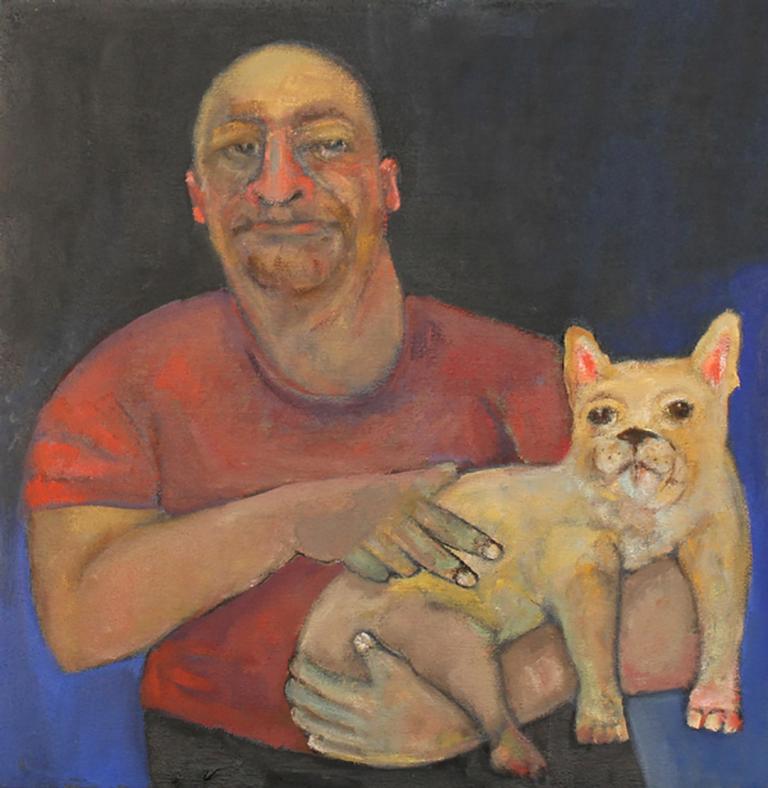Items Similar to "Girl with Guitar" Robert Gwathmey, Music, Southern Social Commentary, Modernism
Want more images or videos?
Request additional images or videos from the seller
1 of 14
Robert Gwathmey"Girl with Guitar" Robert Gwathmey, Music, Southern Social Commentary, Modernism1965
1965
About the Item
Robert Gwathmey
Girl with Guitar, 1965
Signed upper right
Oil on canvas
16 x 20 inches
Provenance:
The artist
ACA Galleries, New York
Mr. Moses Asch, New York
Terry Dintenfass Gallery, New York
Christie's East, November 14, 1991, Lot 440
Private Collection
Catherine Dail Fine Art, New York
Exhibited:
New York, Terry Dintenfass Gallery, Paintings and Silkscreen Prints, January 7 - 30, 1993.
New York, ACA Galleries, A Black Perspective, December 8, 2020 - May 1, 2021.
Richmond, Virginia Museum of Fine Arts, Storied Strings: The Guitar in American Art, October 8, 2022 - March 19, 2023, fig. 5.7, p. 102-4, illustrated; this exhibition traveled to Nashville, Tennessee, Frist Art Museum, May 26 - August 13, 2023.
Literature:
"Virginia Museum showcases guitar’s role in shaping America," Travel Courier, November 17, 2022, illustrated.
Steve Yarbrough, "The Sound of Wood and Steel," The American Scholar, May 25, 2023, illustrated.
W.A. Demers, "Storied Strings: The Guitar In American Art," Antiques and the Arts, November 8, 2022, illustrated.
Robert Gwathmey was a twentieth century artist who utilized his southern heritage as primary subject matter for his paintings. Although he lived most of his life in New York, he was born near Richmond, Virginia and traveled home frequently. An eighth-generation Virginian, Gwathmey was deeply impressed by his Southern heritage, something that is reflected by the imagery in his work.
Gwathmey's first formal artistic studies occurred in his twenties when he moved to Baltimore and enrolled at the Maryland Institute. "When I went to Baltimore to study art, the first thing I saw was Negro policemen and statues of Yankee generals. It was my first trip north, the farthest North I'd ever been, and I was 22 years old. When I got back home, I was shocked by the poverty. The most shocking thing was the Negroes, the oppressed segment. If I had never gone back home, perhaps, I would never have painted the Negro. I was shocked at the red clay, at the redness of the clay. The green pine trees and red clay were everywhere. The Negro seemed to be everywhere, too, omnipresent. But he was a thing apart, so segregated. When people ask me why I paint the Negro, I ask 'Don't artists have eyes'?"
Gwathmey advanced to studies at the Pennsylvania Academy of the Fine Arts where he won a Cresson scholarship that enabled him to travel to Europe during the summers of 1929 and 1930. There he saw the work of many artists covering a wide range of history; but apparently, he gravitated to the Gothic style above others.
Following his studies there, he taught at several schools in Pennsylvania before settling permanently in New York. Although New York became Gwathmey's favorite city in which to live and paint, he continued his established tradition of returning home to the South to visit family every year. In 1942, Gwathmey joined the faculty of the Cooper Union in New York, where he taught for 26 years.
In 1944-45, he received a Rosenwald Fellowship to live and work on a tobacco farm in North Carolina. Such an experience entrenched his work with rural southern themes and provided him with first-hand experiences to transfer to the canvas. The farmers particularly fascinated Gwathmey, their lean bodies with deliberate and stiff actions and often portrayed them as Christ-like figures.
Although the 1950s surge of Abstract Expressionism was definitely the reigning aesthetic of the time, Gwathmey took a stand against this movement, protesting against its rejection of representational art. He remained dedicated to the figural tradition, still relying on his subject matter to distinguish much of his art.
While Gwathmey was often labeled a "Social Realist," his imagery focusing on the lives of the African-American minority moves beyond pure social commentary on the plight of their situation within American society. Gwathmey remained true to his subject matter, but his exploration manifests a unique visual language. His work demonstrates a modernist tendency to abstract shapes, forms, and colors, all the while never abandoning the human figure. He incorporated such elements as large bands of color, low horizon lines, fragmentation of the human body, and completely flat picture planes into his paintings.
Gwathmey's distinctive style successfully fuses the formal elements of modern expression with a deeper, older tradition of realism. Despite the strength of Gwathmey's social and political commitments, perhaps his most effective work is less about advocacy for social change than an examination of the nature of community and the relationships between the races and sexes within his region.
Gwathmey's painting does not invoke social commentary per se, asking more for contemplation than pure action about the scene. Gwathmey's figures mimic the stained glass windows of the Gothic cathedrals he had seen almost two decades earlier with bright colors, bold patterning, and outlines in black. Pattern moves throughout his picture plane, typical of Gwathmey's ability to unite the figures into a tightly controlled, yet rhythmical composition.
Gwathmey himself stated, "I believe that in painting the use of limited imagery is the best method of presentation of your content. I believe that if the symbols are strong enough and simple enough and inventive enough, they can transcend literary [sic., literature?] in painting. One technical way of gaining this end is with simplified pattern. I'd also like to say that this is a modern way of painting…"
- Creator:Robert Gwathmey (1903 - 1988, American)
- Creation Year:1965
- Dimensions:Height: 17 in (43.18 cm)Width: 21 in (53.34 cm)
- Medium:
- Movement & Style:
- Period:
- Condition:
- Gallery Location:New York, NY
- Reference Number:1stDibs: LU1841213501302
About the Seller
5.0
Platinum Seller
These expertly vetted sellers are 1stDibs' most experienced sellers and are rated highest by our customers.
Established in 2021
1stDibs seller since 2022
59 sales on 1stDibs
Typical response time: 1 hour
- ShippingRetrieving quote...Ships From: New York, NY
- Return PolicyA return for this item may be initiated within 3 days of delivery.
More From This SellerView All
- "Nude by the Mirror" Mid-Century Modern Expressionist and Cubist FigureBy Byron BrowneLocated in New York, NYByron Browne (1907 - 1961) Nude by a Mirror, 1958 Oil on canvas 26 x 20 inches Signed lower right Provenance: Doyle New York, Doyle + Design, June 7, 2017, Lot 20 Born in Yonkers,...Category
1950s American Modern Interior Paintings
MaterialsCanvas, Oil
- "In Foreign Parts" Eugene Higgins, Southwestern Pueblo, Modern FigurativeBy Eugene HigginsLocated in New York, NYEugene Higgins In Foreign Parts, circa 1913 Signed lower right Watercolor on paper Sight 17 x 13 inches Born William Victor Higgins in 1884 to a Shelbyville, Indiana farm family where the only art Victor was aware of as a child was his father's love of flowers. "He loved their forms and their colors, and he tended his garden as a painter might work a canvas." At the age of nine, Victor met a young artist who traveled the Indiana countryside painting advertisements on the sides of barns. He purchased paints and brushes so the young Higgins could practice his own artwork on the inside of his father's barn. He also taught Victor about art museums and especially about the new Chicago Art Institute. This information never left the young artist, and he saved his allowance until his father allowed him at the age of fifteen to attend Chicago Art Institute. He worked a variety of jobs to finance his studies both there and at the Academy of Fine Arts. Victor Higgins traveled to New York in 1908, where he met Robert Henri, who became a significant influence by depicting every-day scenes and stressing the importance of the spirit and sense of place as important factors in painting. Higgins was also greatly affected by the New York Armory Modernism Show of Marsden Hartley in 1913. While Victor Higgins was in Chicago he met former mayor and avid collector Carter H. Harrison who was to prove instrumental in the growth of Higgins career for several years. Harrison agreed to support Higgins for four years to go to Paris and Munich and paint and study in the great museums in Europe. While at the Academie de la Grande Chaumier in Paris (1910-1914) he met Walter Ufer, who was another Chicago artist being sponsored by Carter Harrison. This meeting was not only a life-long friendship, but the beginning of a great change in the way Higgins looked at "American" art. He decided that America needed it's own authentic style rather than the 19th Century classic style he was taught in Europe. Very soon after returning to Chicago in 1914, Harrison sent him and Walter Ufer on a painting trip to Taos, New Mexico for a year in exchange for paintings. Higgins made other similar agreements and was able to support himself with his painting. This trip was a life-changing experience and introduced Higgins to the authentic America he had been looking for. In 1914 Taos was an isolated village about twelve hours from Santa Fe on an impossible dirt road. But the colorful life of the pueblo people and the natural beauty drew a collection of artists who became the Taos art colony, from which the Taos Society of Artists was founded in 1915. Victor Higgins became a permanent resident within a year of his arrival and a member of the society in 1917, exhibiting with Jane Peterson in 1925 and with Wayman Adams and Janet Scudder in 1927. The members would travel around the country introducing the Southwest scenes with great success. He remained a member until the Society's dissolution in 1927. Higgins was the youngest member of the group of seven. Other members were Joseph Henry Sharp, Bert Phillips...Category
1910s American Modern Figurative Drawings and Watercolors
MaterialsWatercolor, Paper
- "Pueblo Indians, Taos, New Mexico, " Georgia Klitgaard, Southwest LandscapeBy Georgina KlitgaardLocated in New York, NYGeorgina Klitgaard Pueblo Indians, Taos, New Mexico Signed lower right Oil on canvas 18 x 24 inches Georgina Berrian was born in Spuyten Duyvil, New York in 1893. She was educated a...Category
Mid-20th Century Modern Landscape Paintings
MaterialsCanvas, Oil
- "Portrait of a Woman with Red Hat, Paris, " Isabella HowlandLocated in New York, NYIsabella Howland Portrait of a Woman, Paris, 1925 Oil on canvas laid on board 19 1/2 x 16 1/2 inches Provenance: Hammer Galleries, New York Private C...Category
1920s Modern Figurative Paintings
MaterialsCanvas, Oil, Board
- "Tully Lumber Mill, Orange, Massachusetts, " Dorothy Eaton, WPA Factory RuralLocated in New York, NYDorothy Eaton Tully Lumber Mill, Orange, Massachusetts, 1935 Signed and dated lower right Oil on canvas 17 1/2 x 23 1/2 inches Dorothy Eaton was born in East Orange, New Jersey in 1893. She studied at Smith College...Category
1930s American Realist Landscape Paintings
MaterialsCanvas, Oil
- "Pyroclastic Fever, " Nigel Cooke, Contemporary Painting, Lightning SkyscapeBy Nigel CookeLocated in New York, NYNigel Cooke (Born 1973) Pyroclastic Fever, 2002 Oil on canvas 60 1/2 x 84 1/2 inches Signed, titled and dated "NIGEL COOKE 'PYROCLASTIC FEVER' 2002 Nigel C...Category
Early 2000s Contemporary Abstract Paintings
MaterialsCanvas, Oil
You May Also Like
- Six O'ClockLocated in Los Angeles, CASix O-Clock, c. 1942, oil on canvas, 30 x 20 inches, signed and titled several times verso of frame and stretcher (perhaps by another hand), marked “Rehn” several times on frame (for the Frank K. M. Rehn Galleries in New York City, who represented Craig at the time); Exhibited: 1) 18th Biennial Exhibition of Contemporary American Oil Paintings from March 21 to May 2, 1943 at The Corcoran Gallery of Art in Washington, D.C. #87, original price $450 (per catalog) (exhibition label verso), 2) Craig’s one-man show at the Frank K. M. Rehn Galleries, New York City, from October 26 to November 14, 1942, #10 (original price listed as $350); and 3) Exhibition of thirty paintings sponsored by the Harrisburg Art Association at the State Museum of Pennsylvania in Harrisburg in March, 1944 (concerning this exhibit, Penelope Redd of The Evening News (Harrisburg, Pennsylvania) wrote: “Other paintings that have overtones of superrealism inherent in the subjects include Tom Craig’s California nocturne, ‘Six O’Clock,’ two figures moving through the twilight . . . .” March 6, 1944, p. 13); another label verso from The Museum of Art of Toledo (Ohio): original frame: Provenance includes George Stern Gallery, Los Angeles, CA About the Painting Long before Chris Burden’s iconic installation outside of the Los Angeles County Museum of Art, Urban Light, another artist, Tom Craig, made Southern California streetlights the subject of one of his early 1940s paintings. Consisting of dozens of recycled streetlights from the 1920s and 1930s forming a classical colonnade at the museum’s entrance, Burden’s Urban Light has become a symbol of Los Angeles. For Burden, the streetlights represent what constitutes an advanced society, something “safe after dark and beautiful to behold.” It seems that Craig is playing on the same theme in Six O-Clock. Although we see two hunched figures trudging along the sidewalk at the end of a long day, the real stars of this painting are the streetlights which brighten the twilight and silhouette another iconic symbol of Los Angeles, the palm trees in the distance. Mountains in the background and the distant view of a suburban neighborhood join the streetlights and palm trees as classic subject matter for a California Scene painting, but Craig gives us a twist by depicting the scene not as a sun-drenched natural expanse. Rather, Craig uses thin layers of oil paint, mimicking the watercolor technique for which he is most famous, to show us the twinkling beauty of manmade light and the safety it affords. Although Southern California is a land of natural wonders, the interventions of humanity are already everywhere in Los Angeles and as one critic noted, the resulting painting has an air of “superrealism.” About the Artist Thomas Theodore Craig was a well-known fixture in the Southern California art scene. He was born in Upland California. Craig graduated with a degree in botany from Pomona College and studied painting at Pamona and the Chouinard Art School with Stanton MacDonald-Wright and Barse Miller among others. He became close friends with fellow artist Milford Zornes...Category
1940s American Modern Landscape Paintings
MaterialsCanvas, Oil
- The Landing/Dawn LandingLocated in Los Angeles, CAThis painting is part of our exhibition America Coast to Coast: Artists of the 1940s. The Landing/Dawn Landing, 1944, oil on canvas, signed lower left, 20 x 30, titled verso; exhib...Category
1940s American Modern Paintings
MaterialsCanvas, Oil
- Fish Story oil painting by Williams Charles PalmerLocated in Hudson, NYThis painting is illustrated in the Catalogue of the 1945 Encyclopedia Britannica Collection of Contemporary American Painting, p.84. Written and edited by Grace Pagano. "Painting ...Category
Mid-20th Century American Modern Figurative Paintings
MaterialsOil, Canvas
- Industrial Mid-20th Century WPA Modern Men Working American Scene Social RealismLocated in New York, NYIndustrial Mid-20th Century WPA Modern Men Working American Scene Social Realism George Pearse Ennis (American, 1884-1936) "Forging a Gun Tube #1...Category
1910s American Modern Interior Paintings
MaterialsCanvas, Oil
- The SwingBy Will BarnetLocated in New York, NYSigned lower right: Will Barnet; on verso (photo available): Will Barnet / Aug 1963Category
Late 20th Century American Modern Figurative Paintings
MaterialsCanvas, Oil
- mr. c and gladys, bright colorful man and dogBy Stephen BassoLocated in Brooklyn, NY*ABOUT Stephen Basso Stephen Basso's highly original pastels and oil paintings are romantic, yet thought provoking fantasies. His whimsical works are alive with boundless imagina...Category
2010s American Modern Animal Paintings
MaterialsCanvas, Oil
Recently Viewed
View AllMore Ways To Browse
Antique European Oil Painting Farm
Horse Painting Fabian
Franz Van Sever
Helen Alton Sawyer
Le Lanne
Miniature Pinscher
Indian Fine Art
Womens H
Oil Painting Of Two Men
Vintage Toy Instrument
Sir Arthur Fell
Etienne 1974 Oil On Canvas
Female Sketch
Linda Adair
Christine Ilewski
Eternal Sunshine Of The Spotless Mind
Oil Paintings By Albert Goldman
Terracota Oil

